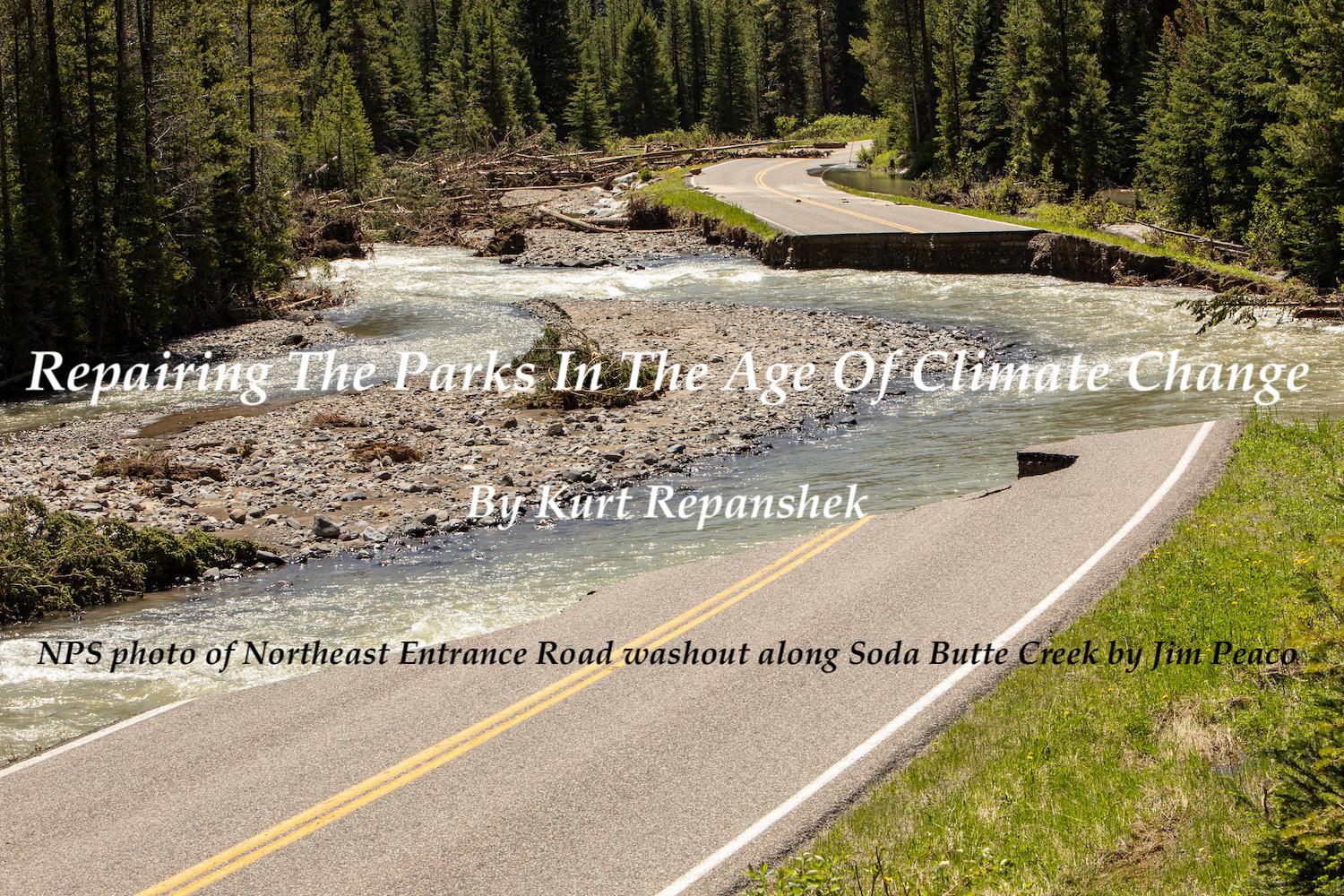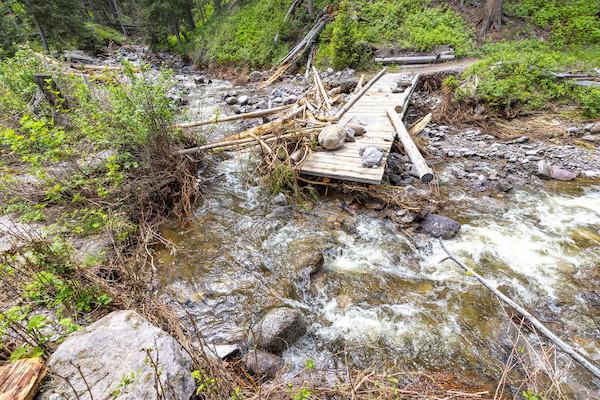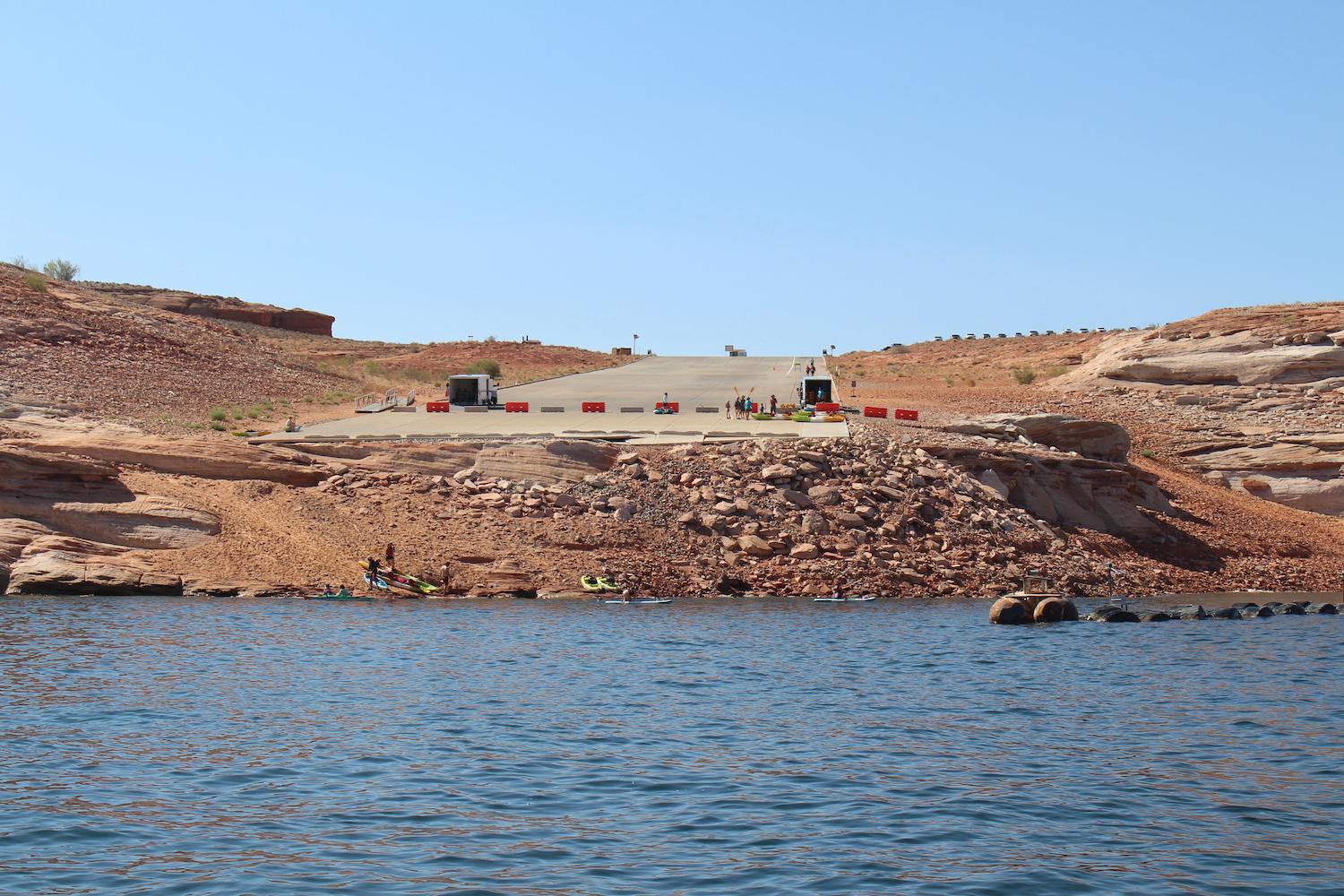
Climate-change driven events are proving costly for the National Park Service, as impacts from drought, flooding, and landslides in just the past year are expected to cost nearly $2 billion to address, and that comes on top of hundreds of millions of dollars the agency unexpectedly needed from Congress in the past decade to address other weather-related impacts.
The bills coming due raise the question of whether Congress needs to increase its funding to the Park Service so infrastructure needs are proactively addressed with climate change in mind, although the uncertainty of where and when the next storm, or wildfire, or flood event will occur is a moving target.
"I don't know that you can just build a fund for the rainy day events that are going to come, even though we know they're coming," Yellowstone National Park Superintendent Cam Sholly said last week, less than two months removed from an unprecedented flooding event along the Gardner and Lamar rivers that destroyed large swaths of the park's North Entrance Road and smaller sections of the Northeast Entrance Road. "Let's try to make sure that we've got the right amount of funding to make the investments that we need to under normal circumstances, and [ensure] that we're rebuilding properly to be resilient for the future."
The High Cost of Climate Change
Natural disasters are not unusual in the National Park System. However, climate change is making them more costly, and in the case of Yellowstone's flooding, unusual.
"Yellowstone hasn't flooded that much, so I think it's an example of, even if we think climate change impacts aren't going to happen in certain areas, they're very possible," said Sholly. "And so it's more of a matter of when, not if. It's important that we incorporate that into all of our thinking as we as we move forward into the second century."
Disasters in the park system often are costly. Four years ago the months-long eruptions of Kīlauea volcano at Hawai'i Volcanoes National Park resulted in damages that still are being addressed but which have already surpassed $100 million (U.S. Geological Survey alone received $98.5 million in 2019 supplemental funds). The 2017 hurricanes of Harvey (Gulf Coast), Irma, and Maria (both Atlantic storms) led to Congress being asked to provide nearly $300 million in disaster relief to the Park Service, while 2012's Hurricane Sandy (aka Super Storm Sandy) prompted supplemental appropriations of nearly $385 million ($348 million via supplemental appropriation and $35 million from the Interior secretary's discretionary fund) to the Park Service.
Exactly what it will cost to repair Yellowstone remains to be seen, but the storm event June 12-13, when 2-3 inches of rain fell on 5 inches of snowpack and turned the Lamar and Gardner rivers, and their tributaries, into raging torrents, did extensive damage. The damage to the North and Northeast entrance roads is well-known, but the floodwaters also took out sections of trails, backcountry footbridges, and scoured the landscape around the Roosevelt Lodge Cabin complex. A pipeline that funnels wastewater from Mammoth Hot Springs down to Gardiner, under the Gardner River, broke and sent 200,000 gallons of wastes downstream. Other wastewater systems in Yellowstone also experienced failures. Flood damage was inflicted on some campgrounds. The Lower Blacktail Patrol Cabin was washed downstream, and a house in Gardiner that was home to some Yellowstone workers was pulled off its footings and sent floating downriver.
The above video of the Lamar River near the Trout Lake Trailhead along the park's Northeast Entrance Road was taken 10 days after the flooding/NPS, Jacob W. Frank
For now Congress is being asked to provide billions of dollars to 1) help Yellowstone rebuild after the flooding; 2) help Glen Canyon National Recreation Area and Lake Mead National Recreation Area cope with the longest Southwestern drought in the past 1,200 years, and 3) rebuild the Denali Park Road across the Pretty Rocks area that has slowly been slipping downhill since the 1990s.
"As climate change increases the severity and frequency of wildfires, flooding, and other weather-related events, the [Senate Appropriations] Committee finds that additional resources are needed to ensure that the Service can protect these treasured spaces and continue to make them accessible to the public," reads a summary of the committee's Fiscal 2023 appropriations bill for the Interior Department. "Recent disasters such as catastrophic flooding impacting Yellowstone National Park and its gateway communities make it clear that funding beyond the scale of the annual bill is insufficient to recover from major disasters. Funding is provided totaling $1.233 billion for Yellowstone National Park, $121.2 million for Denali National Park and Preserve, $320 million for Lake Mead National Recreation Area and Glen Canyon National Recreation Area, and $153.5 million for other disaster recovery needs."
That funding proposed by the appropriations committee, if approved, would come atop $1.9 billion the Park Service, Bureau of Land Management, Fish and Wildlife Service, Bureau of Indian Education, and the Forest Service would receive as scheduled from the Great American Outdoors Act to address maintenance backlogs, and in addition to $3.578 billion the committee proposes for the Park Service's FY23 budget, an increase of $313 million from the current fiscal year.
The lion's share of the disaster recovery funding approved by the committee -- $1.233 billion -- would go to Yellowstone, where engineers and managers are working to determine how best to rebuild after the floods. Sholly said he and his staff have been working closely with top regional and national staff from the Park Service and Federal Highways Administration on the matter, and many members of Congress have visited to understand the challenges.
"We have put together a range of of estimates that will be completely satisfactory in getting the job done here and moving forward. I'm not going to comment on the [appropriation committee's] markup. I'm really happy it's moving as quickly as it is," said the superintendent. "I'll leave that to Washington and the [Interior] department and OMB [Office of Management and Budget] to help kind of navigate that with the [Capitol] Hill. But a lot of people are very interested in what's happened here. We've given them the best information that we can in a kind of an unclear situation. And I feel like that support is going to be coming for us."
The above aerial video taken immediately after the flooding shows some of the damage to the park's North Entrance Road.
The ultimate plan for rebuilding the North Entrance Road well could surprise many and represent a significant realignment from the path that's long been used to reach Mammoth Hot Springs from Gardiner, Montana, as rebuilding in the Gardner River Canyon would not necessarily eliminate the threat of future problems from flooding or landslides.
"I'm not a big fan of rebuilding through the canyon," said Sholly. "I think restoring that canyon [to its natural contours] would be really good for a variety of reasons."
The possibility of future floods similar to the ones that hit in June would require raising the road corridor higher above the river, which at the same time could place it in danger of rockfalls, he said.
"You might be able to withstand another flood, but at some point I think that canyon's vulnerable to rock slides and other things that could damage the structure," said Sholly.
While the superintendent didn't specifically identify a course for the road, he did say that, "[W]e've asked Federal Highways and our engineering teams to look at what are the corridors that are potentially constructible? And what do those alignments look like? And then kind of have a criteria that we will follow. Obviously, we'll conduct an [environmental impact statement] for the North Entrance Road, but what is the least environmentally impacting? What is the least visually impacting? Where can we take advantage of infrastructure that was unaffected, that is not vulnerable to future climate change events? What is the shortest distance? All of these different factors we'll look at try to come up with two or three main alternatives that we'll put forward in an EIS and a planning process."
Sholly was of the opinion that a corridor could be found outside of the canyon that not only would allow for construction to proceed more quickly than rebuilding through the canyon and which would have much less of an environmental impact. And those impacts would be offset by restoration of the river canyon, he added.

A bridge along the Lost Lake Trail near Roosevelt Lodge was just one taken out by the June flood event/Jacob W. Frank
"I think there's only a couple of obvious alignments that can be chosen," Sholly continued. "I also think, getting out of the canyon and restoring it, you could have some environmental gains in some areas. At the very least you would offset whatever corridor you decided to rebuild in. But we've got a couple of good ideas of some areas that I think are going to be pretty light from an environmental impact standpoint, visually, almost invisible, allow us to restore the canyon, and do it quicker than we might have thought."
Rebuilding the Northeast Entrance Road isn't expected to be as challenging. The landscape along the Lamar River there is much gentler than in Gardner Canyon, and the flooding didn't do as much road damage as it did along the North Entrance Road. As a result, there won't need to be a lot of realignment, just rebuilding and possibly some "armoring," said the superintendent.
Repairing Damage Takes Time And Dollars
While Sholly voiced optimism that the road work could be completed in less than five years, an initial timeframe tossed out, rebuilding after disasters can take longer than anticipated. Today's supply chain knots and worker shortages can exacerbate the delays. At Everglades National Park in Florida, repairs and rebuilding are continuing nearly five years after Irma and Maria barreled over the park.
“Recovery feels very real to us at this point as we approach the final stretch with major projects, such as the reconstruction of the Guy Bradley Visitor Center in Flamingo and the contracting of the Marjorie Stoneman Douglas Visitor Center [a new facility to replace the one the hurricanes destroyed] in Everglades City," said Superintendent Pedro Ramos in an email. "The total hurricane recovery funding for the South Florida Parks and Preserve was $78.5 million. Two-thirds of the total number of projects for South Florida have now been completed and the others are underway. Working to implement the recovery program here has been a bit challenging due to issues related to the shortage of supplies and labor, but we are feeling really good about the quality of investments we are making, knowing that from a facilities perspective we will be much more resilient into the future.”
The Everglades superintendent added that the designs used in the recovery work "include improved sustainability to address relative sea level rise and increased storm intensity."
Across the country in Alaska, engineers are optimistic that the Denali Park Road can be rebuilt across the Pretty Rocks slide area in just two years. The work, which began this spring, focuses on constructing a 400-foot-long bridge to span the slide area. It's an expensive project, with $25 million for it coming from the Bipartisan Infrastructure Law, but nevertheless that price tag pales compared to the bill the Park Service faces in Yellowstone.
At Glen Canyon NRA in Utah and Arizona, the drought that took hold of the Southwest in 2000 and has refused to let go has steadily lowered Lake Powell, the recreational highlight of the park. As the lake level has dropped, the Park Service's expenses have grown. In 2009 the agency figured it would need $750,000 to deepen the Castle Rock Cut, which shortens boat travel along Lake Powell between Wahweap and Warm Creek bays by about 12 miles. Contractors removed nearly 87,000 cubic yards of material and lowered the depth of the Cut by approximately 8 feet to open the shortcut for boaters. In early 2013, another project lowered the bottom elevation of the Cut to approximately 3,600 feet. But the work for 2013 was largely in vain—the water never rose high enough during the summer tourist season for the deepened cut to be used by boaters.
In 2014 workers again tackled the Cut, aiming to lower the elevation to about 3,580 feet, and an unusually high runoff that year allowed it to reopen to boaters. However, in the years since Lake Powell levels time and again have closed the Cut to motorized watercraft. The continuing decline of the lake also has placed many of the NRA's motorized boat ramps out of use, as they no longer reach the water. The Park Service back in December hired a contractor to identify "possible long-term solutions and options" for boating access, and the Senate Appropriations Committee factored the costs of that work into its Interior funding bill.
All those unexpected bills, and others from across the National Park System, turn into a very large sum, and could lead the Park Service to take unobligated funds from other parks to "cover costs at Yellowstone until Congress comes through,” said John Garder, the National Parks Conservation Association’s senior director of budget and appropriations.
“They are working off of that DOT money, and it wouldn’t be a surprise if they eventually had to borrow from various unobligated balances across the system to cover their bases until they get the supplemental,” he said in an email.
Taking unspent funds from other parks to help with Yellowstone's recovery would not be highly unusual. Back in 2014, 88 units of the National Park System, from Acadia National Park to Yosemite National Park, provided $49.6 million in an open-ended loan to help Grand Canyon National Park buy down the Lease Surrender Interest -- a sum that reflects a concessionaire's investments in park facilities -- Xanterra Parks & Resorts held in concessions on the park's South Rim.

The Southwest's long-running drought has left many Glen Canyon NRA boat ramps high and dry, including this one, Antelope Point. Addressing the dropping water levels is an expensive proposition/NPS file from August 2021
Anticipating Climate Change's Financial Impacts
Anticipating natural disasters driven by climate change in the park system and how to pay for them is likely to continue to be a vexing problem
"At a minimum, it’s critical Congress continues to provide every dollar of requested supplemental disaster funding to the Park Service, because neither the agency nor appropriators can afford to absorb those costs when they are as high as Yellowstone and other recent disasters--many of them climate-related," said Garder. "These costs also point to the need for Congress to proactively fund park infrastructure through bold bipartisan actions like extending the Great American Outdoors Act’s Legacy Restoration Fund for at least another five years. That would allow them to address a greater share of the maintenance backlog than current funding allows, as well as incorporate resilient materials and designs to ensure longevity and to withstand violent natural events."
Beyond those needs, he continued, attention needs to be paid to "long-term planning for infrastructure, in parks and communities. The Inflation Reduction Act must move through Congress promptly to address park needs and the climate crisis more broadly and in the long term Congress would do well to plan for continuing funding for national park needs related to climate change, and that should include the concept of a dedicated fund."
Back at Yellowstone, Sholly said much the same. There's no question, he said, that climate change is generating greater weather-related impacts on the parks, and so "how we take more substantive actions to understand what we need to do to adapt to those changes, and to predict them and defend the system in a better way, I think is going to be our challenge moving forward."
"A lot of the infrastructure in the National Park System, whether it's transportation -- roads or structures, or whatever the case is -- was put into place long before climate change was really in the forefront of any of our conversations over the past 100 years, or more," he added. "And so I think the question is how do we protect the resources that we have and the infrastructure that we have? How do we guard against future climate change events? And then how do we build for more resiliency into the future? And so we have opportunities to redesign roads or rebuild infrastructure. Are we doing the best that we can to understand what has happened in the past and what will happen in the future and adjusting those investments accordingly?"

Add comment